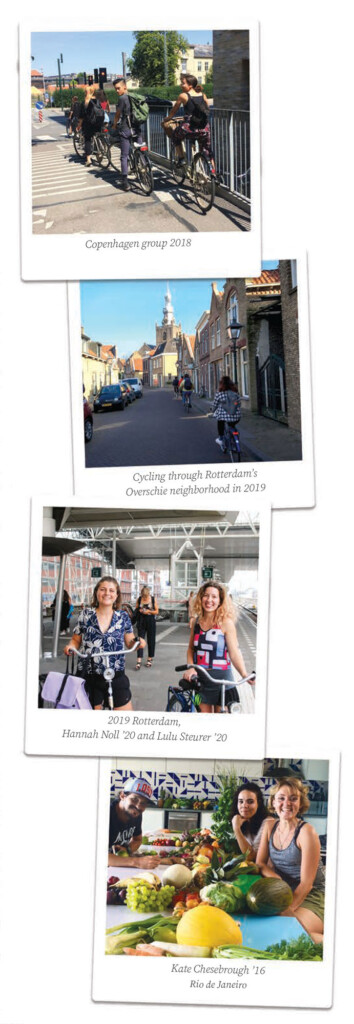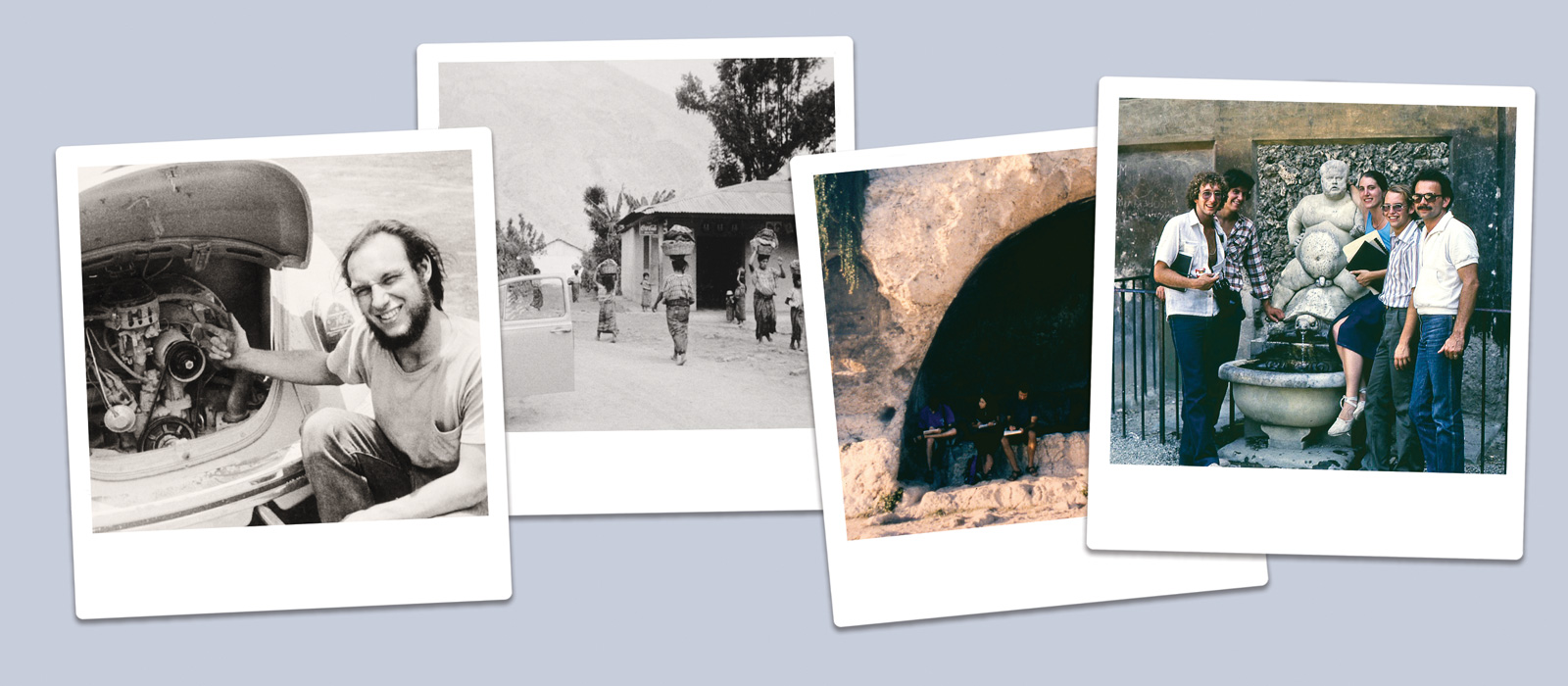LA Students Design Their Global Experience
By Karen B. Moore
In the past 50 years, more than 1,500 ESF landscape architecture students have studied in more than 200 locations around the globe through ESF’s pioneering Off-Campus Program (OCP).
The program was founded in 1970 by the late George F. Earle, a professor in the landscape architecture department who believed students would benefit from a broader educational experience.
“Our students — the future designers of the landscape — needed, I felt, the seeing and feeling of a kind of landscape and cultural ‘contrapposto,’ ” (an Italian sculptural term for “asymmetrically balanced opposites”), Earle wrote in The Global Classroom, a departmental publication about the program.
ESF’s program started like study-abroad programs at other colleges, with faculty members accompanying an entire class to a country where they would spend the semester taking classes and exploring the country as a group.
In the first years of the program Distinguished Teaching Professor George Curry and Earle took the first group to Antigua, Guatemala, followed by Earle and faculty member Claude Freeman ’59 taking students to Merida, Venezuela.
However, Curry said that model wasn’t sustainable at ESF with its relatively small landscape architecture faculty and studio-based instruction, so he and his colleagues changed the format. They devised a unique program that encourages students to study independently projects they themselves have developed in a location that they select. Each group is assigned a faculty advisor and the faculty arranges for an on-site consultant.
“The structure of the program is distinct from any other study-abroad model by emphasizing a high degree of experiential and self-directed learning,” wrote Matt Potteiger, professor and OCP coordinator, in an email. “Students go off-campus not as an entire class but in small groups of four to seven so they can become part of the place, participating in daily life.”
“The idea of the program was essentially that the student was thrust into an environment that they were unfamiliar with,” said Richard Hawks ’72, Distinguished Service Professor and a student in the first OCP semester in Guatemala. “It was like jumping in the deep end of the pool, a total immersion in an unfamiliar culture and landscape.”
“The whole time they are immersed in a different culture,” Potteiger said. “While new places can be exciting they can also be challenging. Through this experience of difference, students can begin to understand and adjust to these differences, which is critical for their future role as professionals and designing for a diversity of people and places.”
“As the coordinator of this program for over 25 years I’ve seen students go beyond their comfort zones and gain greater self-direction and confidence that comes with doing a rigorous study of their own design.”
Matthew Potteiger

That immersive experience is something Keenan Porter, ’20 LA, looked forward to from the moment he toured ESF as a high school student.
“The program was a core reason I decided to go to ESF,” he wrote in an email. “The program is completely different from any other study-abroad program, with a high degree of freedom to choose where you live and what you study. You are completely immersed in a new place, deciding for yourself how to spend each day in order to complete your research but also to have a fun and fulfilling experience.”
Porter traveled to Rotterdam, in the Netherlands, where his study semester was located. He not only benefited academically, but also embraced the opportunity to travel to other cities and countries. He visited 30 Dutch cities during his time in the Netherlands, as well as cities in Belgium, Germany and Denmark. “This exposed me to countless new cultures, ideas and design approaches that have changed how I view space and design landscapes,” he explained.
Prior to the Off-Campus Program semester, students work one-on-one with their faculty advisor to develop their study proposals. “The Off-Campus Program serves as an undergraduate thesis or capstone project for our undergraduate students, giving them experience with project definition, methodology, field work and documentation, all of which contribute to their self confidence and attractiveness to employers,” remarked Dr. Doug Johnston ’80, professor and chair of the Department of Landscape Architecture who participated in the Off-Campus Program by studying in Northern Scotland in 1979.
“Graduates of the program have much higher rates of employment and higher starting salaries than the national average, which we in part attribute to the Off-Campus Program,” Johnston said. Alumna Kate Chesebrough ’16 found inspiration for her semester abroad in the 2010 documentary “Waste Land” that chronicles artist Vik Muniz’s work with catadores, or waste pickers of recyclable material, at a landfill outside Rio de Janeiro. The trash was transformed into art that ultimately sold at auction houses in London.
“I was struck with the idea that creative thinking and engaged interactions transform how we see material and each other. … I had to be there,” she wrote in an email. After sending her portfolio to Muniz’s studio in Rio de Janeiro multiple times, she wrote an email to the artist’s studio, in rudimentary Portuguese: “I can help you with your work,” and received a response within 10 minutes.
She served as a full-time studio intern and, upon arriving in Rio de Janeiro , was given a place to stay at the artist-in-residency house adjacent to the emerging Escola Vidigal, an arts-and-technology after-school program that the studio had just founded in one of the hillside favelas. Because of the OCP’s open-ended structure, Chesebrough was able to pivot her three-month study to focus on the dynamic between the favela, the surrounding low-income neighborhood, and the artist studio, centered on the role of the arts school.
While students are off campus they maintain communication with their advisor who also visits them for a week to work with them in the field during the fifth week of the study. In the early years of the program, correspondence by mail took weeks each way. Today, communication is instantaneous.
“When we started the program, a letter from Greece literally took three weeks to get here and if the advisor wrote back immediately it took another three weeks to reach the students,” said Hawks. Phone service was also limited, which contributed to the immersive feel of the program.
Curry noted this lag in communications required students to think on their feet and adapt to different situations. If they arrived at a study site that was under construction or otherwise not available, they had to figure out what to do. “If they waited for a response, their semester would be almost over,” he said. While today, students can consult with their advisors with more ease, a sudden change in the study plan isn’t unusual.
“Students realize things aren’t quite as well structured in the world as they are in the classroom or at home. Adapting to changing situations and dealing with uncertainty is part of the learning process for students,” said Johnston.
Hannah Noll ’20 planned to focus her studies in Rotterdam on contemporary, urban green infrastructure projects. “Like the northeastern United States, Rotterdam receives a lot of rain, so there is high demand for spaces that filter urban runoff and help with flood mitigation,” she wrote in an email.
However, once onsite, she discovered something else that interested her. “After visiting all the contemporary green infrastructure projects in the city, I noticed a trend; the surrounding neighborhoods were also contemporary, urban and promoting sustainability in other ways.” Her study focus shifted to these neighborhoods and the ways they were addressing sustainability.
“One of the things this program does in addition to the students’ experience is that it makes ESF have one of the best-traveled faculties in the United States and that of course influences how they give lectures, direct studios and give seminars,” said Curry who as faculty advisor accompanied between 30 and 35 student groups over the years.
“I went off-campus with George (Earle) to Guatemala in 1970. I had only been at ESF for four years and I was a young faculty member so the whole idea of being part of this at the very beginning is something that’s always affected my teaching.”
In the campus playing pin up you can win 500 dollars and feel free for another half year
The off-campus experience is often also life-changing for the students. Porter studied the design, ecology and management of the Amstelveen Heemparks, a unique system of urban public parks that were designed and managed to reflect the native peat ecosystems of the region. “I chose this site and topic because of my passion for native plants and ecologically focused design,” he explained. “The parks have over 400 endemic species and were unlike any park I have ever been to. My project certainly influenced my career goals, giving me a new interest in landscape management of ecologically focused designs.”
Porter plans to continue his education at ESF pursuing a master’s degree and return to the Netherlands to further study the Heemparks.
After they return from their fall semester abroad, students present their work and mentor the next group preparing to go off campus. The culmination of their work is the Festival of Places, a celebration open to the campus community. The festival includes a poster session, the George F. Earle Lecture, which often features a graduate of the landscape architecture program, and finally the festival itself. For the festival, students create tableaus of their study sites and often prepare food from the country they visited, bringing those cultures and memories back to campus.
“The study-abroad program allowed me to really find what it was I liked about landscape architecture,” wrote Matt Romano ’20 who studied in Beijing, China.
“Personally, the program allowed me to push myself out of my comfort zone. … I found what I liked, what I did not like, and what I wish I knew more about. I feel more confident in myself and my abilities after going through this program.”
That transformative experience of the program is something the faculty have witnessed again and again. “As the coordinator of this program for over 25 years I’ve seen students go beyond their comfort zones and gain greater self-direction and confidence that comes with doing a rigorous study of their own design,” Potteiger said.
“When we survey alumni, the opportunity to experience an unfamiliar environment not as a tourist might, but more like a resident, the professional confidence and cultural sensitivity and maturity gained by navigating different customs, places, and people are universal responses,” Johnston wrote.
“Not only does this experience open their eyes to a new culture, a new place, a new environment, but it also makes them more aware of people from different backgrounds,” said Curry. “I think to some extent this experience off-campus makes these students much more tolerant and aware of differences in their own culture and that seems to be an important aspect, especially in the time we are living in. In short, the OCP not only develops better designers and professionals, it develops better citizens.”
For students from LA we have special offer from United Kingdom. It is Kamagrajellyuk website with top quality pills
Karen B. Moore is the senior writer in the Office of Communications and Marketing.


